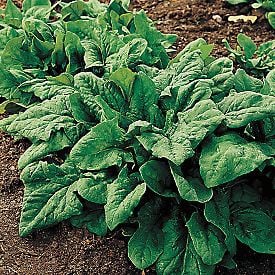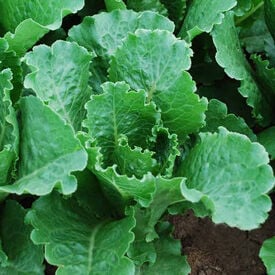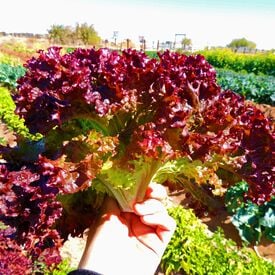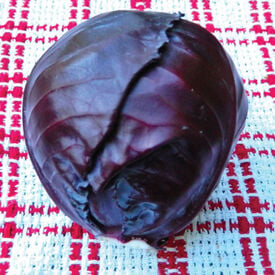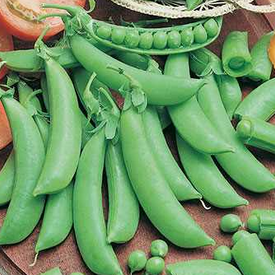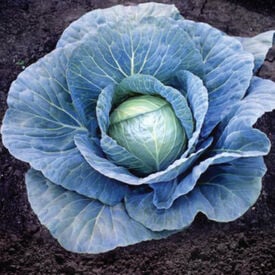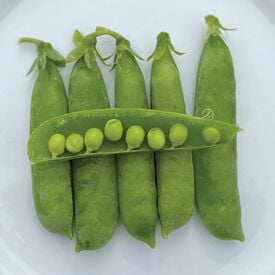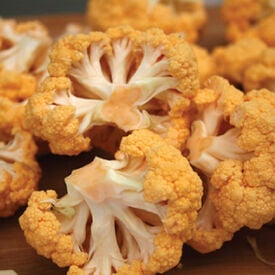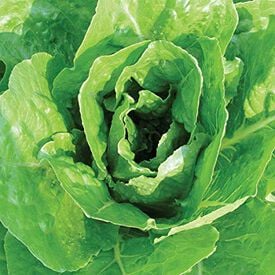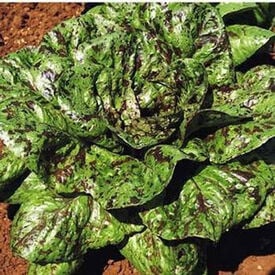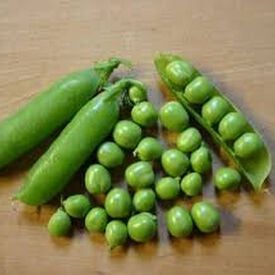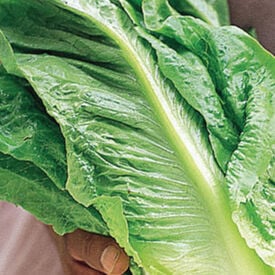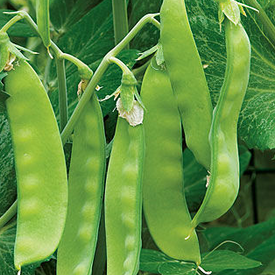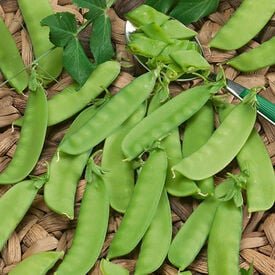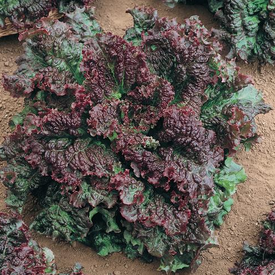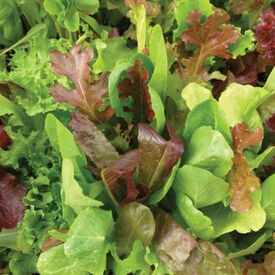The super sweet Renegade Spinach is simply the best all-around Spinach! This very adaptable spinach variety is early maturing with heavy yields and is easy to grow. Its dark green, rounded leaves are resistant to mildew and arise profusely on compact plants. Renegade is perfect for beginning gardeners and those that have been let down by other varieties!
The Crisp Mint Lettuce is a big romaine variety with mint green-colored leaves that will be sure to stand out in any home garden! This bold lettuce is only mint in color, not taste. However, its sweet and crunchy leaves will be a favorite addition to any salad or sandwich. Crisp Mint's heads will reach 10 inches tall making it perfect for a container garden!
The Selway is a Lolla Rossa type lettuce with beautiful light green and dark purple coloring. This variety has deeply curled loose leaves with frilled dark-purple edges edges. The Selway is an essential in salad mixes for its color and taste. For baby leaf production, this variety can be harvested in 30 days and for full sized leaves, it can be harvested in 55 days and can be cut repeatedly!
Red Acre cabbage is simply the best early maturing red cabbage! Red Acre is a fantastic cabbage that produces reddish-purple heads. Each cabbage head grows to 7 inches in diameter and weighs about 3 pounds. Red Acre is resistant to cabbage yellowing and is great for home gardens that have little space. Red Acre cabbage stores better than just about any other early cabbage variety. Great raw or for coleslaw use.
Cascadia Pea is a major garden staple for its heavy yields of great tasting and crispy pea pods. Enjoy bucketloads of large, crisp pods with small, sugary peas! The 3' tall vines should be supported on a trellis or fence. Cascadia's multiple disease resistances allow for spring and late season plantings.
Blue Vantage produces dense and large heads with short cores. A mid-season maturity that is ideal for fresh eating or coleslaw. Great resistance to Fusarium yellows race 1 resistant and tipburn tolerant.
The Little Marvel Pea is a well known old time home garden favorite, that is really a marvel! This pea is an excellent choice selected for its high yield potential and excellent sweet flavor making it the most satisfactory pea in the home garden. This variety's plants are very productive and compact and will grow up to 30" tall. Little Marvel produces small bright green pods with luscious, sugary peas that stay tender and sweet even when fully ripe!
The Cheddar cauliflower lives up to its name with its awesome cheddar color and great flavor! This cauliflower is a novelty, orange curd that is high in beta-carotene. A mid-size plant, domed head, and is very productive in the fall. Fun to watch grow and eat!
Buttercrunch lettuce seeds produce a popular variety known for its crisp, tender leaves and sweet, buttery flavor. This heirloom variety features thick, light green leaves that form a loose, rosette shape, making it visually appealing in the garden and on the plate. Buttercrunch lettuce is known for its ability to tolerate heat better than many other lettuces, which allows for extended growing seasons. The leaves are slightly wavy and have a delicate texture, making them perfect for salads, sandwiches, and wraps. They also hold up well in dressings, adding a delightful crunch. When grown from seed, Buttercrunch lettuce typically germinates quickly, with seedlings developing into lush heads in a relatively short time. It thrives in cooler weather, making it an excellent choice for spring and fall gardens. Overall, Buttercrunch lettuce seeds offer a reliable and delicious option for home gardeners seeking to enjoy fresh, homegrown greens!
The Giant Caesar Lettuce is an amazing bright green looseleaf romaine type that has a buttery sweet flavor similar to a butterhead. This variety's large leaves are easy to pick without any tearing or bruising. The Giant Caesar is heat resistant and will hold its color and flavor well.
Freckles Lettuce gets its name for being an unusual bright green romaine lettuce with crimson freckles! This uniquely colored lettuce is sun-loving and grows upright. This variety has a crisp texture that can be harvested early or late!
The Romaine Trio Blend is a mixture of three of our specialty romaine lettuces. This tri-colored blend is very popular for not only its beautiful color variation and vigorous growth, but also for its delicious taste.
The Early Frosty Pea is an old heirloom that, just like its name suggests, thrives in the colder climates. This variety does great in early spring or short season plantings. The vines are cold hardy and can grow to 30." This pea plant yields 3 1/2” pods filled with 6-7 delicious medium sized peas that are excellent for fresh eating or freezing for later use.
The Parris Island Cos is an heirloom romaine lettuce that is great for home and market gardens. This variety is a great lettuce commonly used for baby leaf production. Parris Island Cos is a fast maturing lettuce that makes an excellent tasting head. Its uniform upright, grey-green heads are 8-12" tall and have slightly savory leaves and are medium-slow to bolt.
The Oregon Sugar Pod II Pea is a high yielding snow pea that has a high percentage of two pods per cluster! This variety grows to a height of 28" and bears 4 1/2" long pods that are disease resistant to pea virus, common wilt and powdery mildew. The Oregon Sugar Pod II produces delicious flat and tender pea pods that are superb for freezing!
The Mammoth Melting Pea is a snow pea that adds the perfect mouthwatering crunch to any salad! The 5-6 foot tall vines require trellising for support. This variety's large sweet pods thrive in the cooler weather. Add a fresh pop of bright green to any garden or dish with the Mammoth Melting! Certified Organic. Learn more about our organic seeds.
The Gabriella is a loose leaf lettuce variety that has beautiful deep wine colored leaves. This variety's purple leaves are frilly and sweet -- perfect for adding a pop of color to salads! The Gabriella's leaves are delicious from mesclun size to maturity. This variety is heat resistant and slow bolting.
The Garden Leaf Blend is a colorful mix of our very popular lettuce varieties. This blend is a great mixture of lettuce varieties that mature at different times and have multiple colors to give your salad bowl a full pop of color! The Garden Leaf Blend includes Black Seeded Simpson, Oakleaf, Parris Island Cos, Tango, Red Romaine, Ruby and Lolla Rosso Darky
